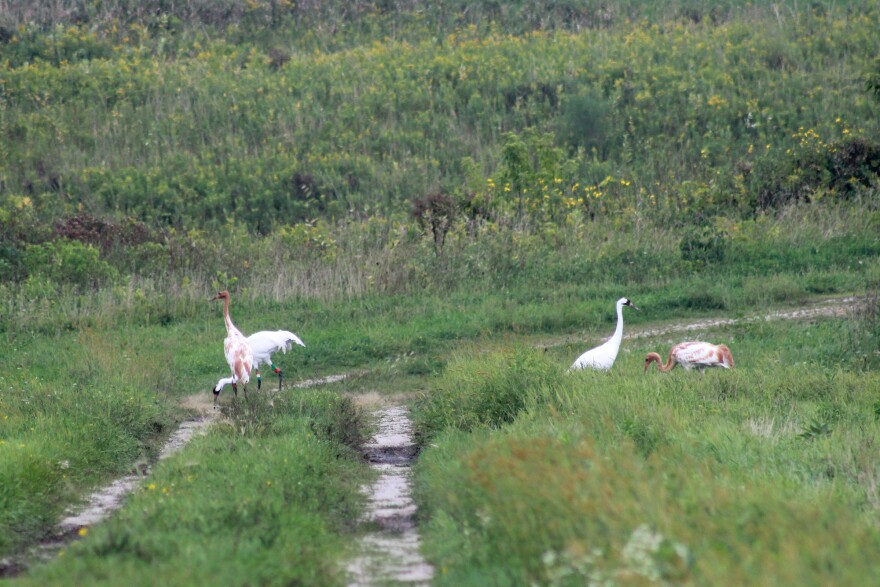About an hour northwest of Milwaukee, there's an innovative wrinkle in Wisconsin's ongoing experiment to create a self-sustaining flock of whooping cranes in the Eastern United States. A family of cranes is living at the Horicon National Wildlife Refuge, after two chicks in the family were born in captivity in Florida, and all the birds were flown there by jet.
It's another chapter in the nearly 20-year effort by scientists to help the tallest flying bird in North America, the 5-foot tall whooping crane. And there has been some success. More than 100 whoopers now migrate between Wisconsin and southeastern states. Most of those birds were brought to Wisconsin as chicks and raised by humans wearing crane costumes and flying ultralight aircraft.

But problems with getting those cranes to reproduce have led researchers, in the last few years, to try other rearing techniques. The latest one is on display at Horicon Marsh.
Beeps come from a tiny transmitter on the leg of an adult male whooping crane nicknamed Grasshopper. Wildlife biologist Hillary Thompson, who's holding an antenna and receiver, can't see the bird. But given the strength of the signal, Thompson estimates he's probably about 300 yards away in an upland area at the eastern edge of the Marsh. That makes Thompson happy.
"It's great! It means they're still here. He is in a part of his old territory, which is good,” Thompson said. “He has moved around since last night, so we know he's still alive.”
Thompson is with the Baraboo-based International Crane Foundation, one of the organizations in the public-private Whooping Crane Eastern Partnership. She says in 2015, Grasshopper, who had been released at Horicon, paired off with a more common sandhill crane.

"We believe [that] happened because he set up a territory and there weren't other whooping cranes here for him to breed with. So, he decided to breed with a sandhill crane," Thompson said.
Scientists didn't want the hatched hybrid chick to be in the wild because it could dilute the whooping crane population. Whoopers are already an endangered species due to widespread habitat loss and over-hunting. So, that chick is now in captivity.
Meanwhile, the researchers could tell Grasshopper was interested in mating. So, researchers paired the male with a female whooper nicknamed Hemlock at a private conservation facility in Florida.
"We have never tried it with whooping cranes from the wild before, which is something we thought might work, because we have whooping cranes in captivity that we paired based on their own behavior or needs for the breeding population in captivity," Thompson said.

She says it's OK — but uncommon — to mix wildlife biology with captive rearing. "This project is back and forth between two worlds all the time and that's not really something that a lot of people do in wildlife science, I think," she said.
So far, the pairing has worked. Four months ago, two crane chicks hatched in Florida, and a couple weeks ago, all four birds were flown to Horicon.
Wildlife Refuge biologist Sadie O'Dell says the marsh's huge expanse of wetlands and large areas off-limits to humans give the family a good chance of surviving. She says the biggest threat is from predators like coyotes and raccoons, so there are efforts to keep the cranes from harm.
"It's pretty difficult. We do what we can to monitor them and hope they're roosting in favorable habitat. If not, we've done some things to try to force them to be roosting in better habitat," O'Dell said, adding that those steps have included shooing cranes off a road and into a wetland.
But even if predators don't harm the birds, there's no guarantee the crane family will bond enough to migrate south this fall.
However, as Hillary Thompson tuned the receiver to the signal from another nearby transmitter, she heard an encouraging sign.
"So, this frequency is actually the oldest chick, which is a female, and she has been hanging pretty tight to dad since we released them," she said.

That's good, Thompson said, "So that the male can show her around, how to find food in the wild, where the good areas are to forage. Usually, if you see a group of whooping cranes foraging, at least one of them will have their head up, looking around, and will take turns looking out for things."
Thompson acknowledges that the use of a jet to fly a whole family of cranes from Florida to Wisconsin is a temporary step back from the goal of a self-sustaining whooping crane flock in the Eastern U.S. But, after all, she says humans had a lot to do with whoopers becoming endangered in the first place, and this is a partial payback to nature.
Support is provided by Dr. Lawrence and Mrs. Hannah Goodman for Innovation reporting.

Do you have a question about innovation in Wisconsin that you'd like WUWM's Chuck Quirmbach to explore? Submit it below.
_



